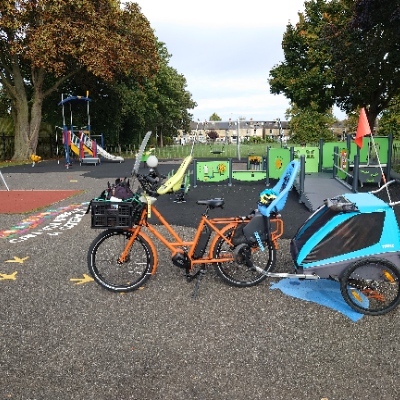Removed by mod
I used to hate them for being slow and annoying. Now they drive like us and I hate them for being dicks. This morning, one of them made an insane move that only the worst Audi drivers in my area do, a massive left over a solid yellow across no stop sign with me coming right at it before it even began acceleration into the intersection.
I had a friend that worked for them in the past. They really aren’t that impressive. They get stuck constantly. While the tech down the line might be revolutionary for people who cannot drive for whatever reason right now it still needs a LOT of work.
@MoreFPSmorebetter @vegeta I just can’t see this type of tech working in places with a more pedestrian-first culture / more unpredictable human behaviour, i.e. countries without jaywalking laws. If you tried to drive this through London and people realised it will just have to automatically stop for you (and also *won’t* stop for you out of politeness if you wait hopefully) then everyone will just walk in front of it. What’s the plan, special “don’t stop the Waymo” laws?
Vegas sure has a lot of pedestrians doing a whole lot of unpredictable things.
@ripcord unpredictable but maybe not standard practice? Just a guess, could be a bad assumption! British driving culture is reliant on eye contact and waves and nods and flashes - you have to signal if you’re giving way (to other drivers as well), and say thank you; lots of places where there’s only room for one vehicle on a two way road and someone has to decide who’s going. Might be my failure of imagination but I don’t know how that works with no driver.
That’s when vehicle to vehicle communication will come into play. When we can automate the driving and link the cars’ comm systems together, it becomes a network management problem.
@dogslayeggs this is not a good solution unless you’re expecting to mandate that all pedestrians, cyclists, scooter riders, guide dogs, whatever, wear them too, and that all existing cars are retrofitted with them. Kind of dystopian.
I was clearly only talking about cars, not pedestrians. Driverless cars have already shown they are pretty good at avoiding pedestrians and cyclists and scooters and dogs. Even in the case of the pedestrian hit by the Cruise car, that pedestrian was hit by another car first and then thrown into the path of the Cruise. The one case of a dog hit by a car was a dog running out from behind parked cars with no time for a human to stop, let alone the Waymo… and dogs don’t usually wave and signal to drivers on the road.
As far as retrofitted cars, this is about improving the current system not requiring 100% compliance. Do you ban people from driving on the roads if they don’t wave at you on a one-car wide road? No. So you don’t have to ban cars that don’t have this tech. But when more and more cars DO have the tech, then you get improvements over time.
It is absolutely common for people to do something unexpected in Las Vegas, particularly near the Strip and other pedestrian-heavy, gambling/drinking-heavy areas.
Erratic driving is also higher than average for most western cities.
My point though was that this is one of Waymo’s main testing areas.
With that said, like other people have mentioned, there are a lot of potential gotchas here like Waymo running on fairly limited routes and still potentially needing a lot of human intervention.
Also the idea that someone can shut down or take over control of my car remotely is extremely creepy and dust I piano seeming to me.
People in London just walk in front of all cars all the time. Including me. That’s not an unpredictable behaviour, that’s a default and very predictable behaviour. If you’re in a car - you stop.
@Aux I’d call it “predictably unpredictable”! Plus the “cyclist swerving round a pothole” roulette.
Obviously we install a padded arm that grabs the pedestrians and throws them back onto the curb so they learn not to just walk out in front of the moving vehicles.
Idk how it is where y’all live but generally people only jaywalk when there aren’t cars driving on the road at that moment. Other than crosswalks it’s kinda expected that if you are going to jaywalk you are going to do it when no car will have to stop or slow down to avoid you. Obviously not everyone follows that rule but generally speaking.
@MoreFPSmorebetter it’s not called jaywalking here, it’s just called crossing the road, and there are plenty of places where if it’s busy if you just kind of wait hopefully someone will wave you across. Or you look for a big enough gap that you can’t make it all the way across but a driver will see you and have to slow. We also have zebra crossings which you just wait next to and drivers have to stop; up to the driver to interpret if someone is just standing around or waiting to cross.
Thing is, the end goal after sorting out all the bugs in the AI is no human druven cars since having both will only lead to crashes dur to AI being unable to predict a human. All the AI cars would be linked to a central system to communicate with eachother and alwats know where eachither are. Then all we have to do is make sure people only use the cross walks and traffic accudents will be solely due to idiots.
I doubt a central system would ever be viable, but they would certainly communicate to other nearby cars with more than just blinky lights
That doesn’t seem like a very high bar to achieve
Because they are driving under near ideal conditions, in areas that are completely mapped out, and guided away from roadworks and avoiding “confusing” crosses, and other traffic situations like unmarked roads, that humans deal with routinely without problem.
And in a situation they can’t handle, they just stop and call and wait for a human driver to get them going again, disregarding if they are blocking traffic.I’m not blaming Waymo for doing it as safe as they can, that’s great IMO.
But don̈́t make it sound like they drive better than humans yet. There is still some ways to go.What’s really obnoxious is that Elon Musk claimed this would be 100% ready by 2017. Full self driving, across America, day and night, safer than a human. I have zero expectation that Tesla RoboTaxi will arrive this summer as promised.
I think “near ideal conditions” is a huge exaggeration. The situations Waymo avoids are a small fraction of the total mileage driven by Waymo vehicles or the humans they’re being compared with. It’s like you’re saying a football team’s stats are grossly wrong if they don’t include punt returns.
You’re not wrong, but arguably that doesn’t invalidate the point, they do drive better than humans because they’re so much better at judging their own limitations.
If human drivers refused to enter dangerous intersections, stopped every time things started yup look dangerous, and handed off to a specialist to handle problems, driving might not produce the mountain of corpses it does today.
That said, you’re of course correct that they still have a long way to go in technical driving ability and handling of adverse conditions, but it’s interesting to consider that simple policy effectively enforced is enough to cancel out all the advantages that human drivers currently still have.
You are completely ignoring the under ideal circumstances part.
They can’t drive at night AFAIK, they can’t drive outside the area that is meticulously mapped out.
And even then, they often require human intervention.If you asked a professional driver to do the exact same thing, I’m pretty sure that driver would have way better accident record than average humans too.
Seems to me you are missing the point I tried to make. And is drawing a false conclusion based on comparing apples to oranges.
I specifically didn’t ignore that. My entire point was that a driver that refuses to drive under anything except “ideal circumstances” is still a safer driver.
I am aware that if we banned driving at night to get the same benefit for everyone, it wouldn’t go very well, but that doesn’t really change the safety, only the practicality.
Waymo can absolutely drive at night, I’ve seen them do it. They rely heavily on LIDAR, so the time of day makes no difference to them.
And apparently they only disengage and need human assistance every 17,000 miles, on average. Contrast that to something like Tesla’s “Full Self Driving” (ignoring the controversy over whether it counts or not), where the most generous numbers I could find for it are a disengagement every 71 city miles, on average, or every 245 city miles for a “critical disengagement.”
You are correct in that Waymo is heavily geofenced, and that’s pretty annoying sometimes. I tried to ride one in Phoenix last year, but couldn’t get it to pick me up from the park I was visiting because I was just on the edge of their area. I suspect they would likely do fine if they went outside of their zones, but they really want to make sure they’re going to be successful so they’re deliberately slow-rolling where the service is available.
Waymo can absolutely drive at night
True I just checked it up, my information was outdated.
driving might not produce the mountain of corpses it does today.
And people wouldn’t be able to drive anywhere. Which could very well be a good thing, but still
I have zero expectation that Tesla RoboTaxi will arrive this summer as promised.
RoboTaxis will also have to “navigate” the Fashla hate. Not many will be eager to risk their lives with them
And yet it’s still the least efficient mode of transport.
What’s more efficient?
In terms of getting to an exact location.
Public transportation only can get you near your target mostly. Not on point like a car, bike etc.
You ever heard of legs? Mass transit gets you the bulk of the way there, and legs will handle the small bit left.
If someone can’t walk a few blocks, that’s on them. Airplanes don’t get you exactly to the destination either. There’s a tradeoff.
@meco03211 @Jayk0b cars can’t either - it’s a false premise. Not everything is drive-thru. How far is, say, the bakery section from your car when you go to the supermarket?
Yeah fuck disabled and elderly people.
Public transportation and walkable cities are much better for the elderly and disabled who often can’t drive due to their age and disability?
Taking a wheel chair or mobility scooter or be guided by your service dog are all subsets of “walk there”.
Rip disabled people.
Bicycles? ride/ walk to were you need to be? Why do you need to be driven to an exact point? All the space needed for parking is just wasted.
You need to create a specific scenario in order to make cars seem more efficient than alternatives. They cause more accidents, take up more space while carrying fewer people at any given time while also causing more pollution than other modes of transport.
Automated vehicles are GPS guided. The US is too big to be walking and biking. That is for an urban environment with proper zoning laws, and serves what amounts to be an ethnic group who shouldn’t need cars. What makes automated vehicles more efficient is the removal of labor and lower operational costs. The specialization of transporting people to the exact GPS coordinates is much more convenient. The future is automated travel because it is much more efficient and vehicles can be used more productively on the margin than everybody having to own their own car. Fewer cars, higher use of the car, means lower transportation costs throughout, which includes infrastructure itself; the less need for insurance, less pollution, etc. This technology can be used in bus transit systems as well for a less marginal benefit.
The “US is too big” is such a bullshit excuse since cars are absolutely crap for long distances compared to trains people already walk and cycle in the US. And why is the richest and most powerful (for now at least) country in the world unable to fix it’s zoning laws? Especially since other countries seem to be able to do it.
Yes, efficiency in reducing the amount of people with jobs but not by getting people from a to b. What is convenient is not having to own a car in the first place and be able to get around with ease because of proper urban planning.
The future is automated travel because vehicles can be used more productively on the margin than everybody having to own their own car. Fewer cars, higher use of the car, or less idling, means lower transportation costs throughout, which includes infrastructure itself; the less need for insurance, less pollution, etc. This technology can be used in bus transit systems as well for a less marginal benefit.
Sooo like a what’s already possible with trains and trams? And buses on dedicated lanes would be far easier to automate and be more efficient than cars.
Trains are for long distances. Trams are for pure urban areas. Metros are for connecting cities within a metropolitan group. All those function within a well planned urban structure, not the suburbs, or exurbs. Cars are the most efficient in the US. That is why most Americans own a car. Without a car, you are asking for long walking distances, and long bike rides. City transit systems don’t work in the US, because too many criminals are out in public, people like their own space, and Americans like the convenience of going, and leaving at their own time. Americans like their own space. Again, you are talking about a specific type of living that most Americans don’t really gravitate to. Americans want a large house in a safe neighborhood in the suburbs, or live in the exurbs. They don’t want to live in crime-ridden urban areas, that is not the American dream.
Look how well that American dream is going
lol
In terms of getting to an exact location, the most efficient is no vehicle, walking.
Cars are less efficient, followed by busses, then probably trains, then boats, then airplanes (unless you parachute).
Cars are the least efficient in terms of moving large numbers of people from places they can then walk from.
It is hard to take you seriously. Open up Google Maps in the USA, and see how long it takes you to walk, and bike to a place. People buy the expense of a car for a reason; biking, and walking, is the least efficient. Transit systems do not work in the US, because everything has to be planned around them. They’re bureaucratic, and rote. City transit systems are the essence of this bureaucracy and rote. It does not serve people as they intend to live.
The most efficient is obviously a combination of methods, using the fastest methods for each leg of the journey.
In the US, right now, taking a car from point to point, then walking into your location is the fastest combination in most cases.
Good transit gets you close enough (as others have said, you don’t drive your car down the aisles of the supermarket). That few people have good transit is the problem that needs to be fixed. Sadly few really care - in the US the republicans hate transit, and the democrats only like transit for the union labor is employees - importantly neither cares about getting people places.
I am once again begging journalists to be more critical of tech companies.
But as this happens, it’s crucial to keep the denominator in mind. Since 2020, Waymo has reported roughly 60 crashes serious enough to trigger an airbag or cause an injury. But those crashes occurred over more than 50 million miles of driverless operations. If you randomly selected 50 million miles of human driving—that’s roughly 70 lifetimes behind the wheel—you would likely see far more serious crashes than Waymo has experienced to date.
[…] Waymo knows exactly how many times its vehicles have crashed. What’s tricky is figuring out the appropriate human baseline, since human drivers don’t necessarily report every crash. Waymo has tried to address this by estimating human crash rates in its two biggest markets—Phoenix and San Francisco. Waymo’s analysis focused on the 44 million miles Waymo had driven in these cities through December, ignoring its smaller operations in Los Angeles and Austin.
This is the wrong comparison. These are taxis, which means they’re driving taxi miles. They should be compared to taxis, not normal people who drive almost exclusively during their commutes (which is probably the most dangerous time to drive since it’s precisely when they’re all driving).
@theluddite@lemmy.ml @vegeta@lemmy.world
to amplify the previous point, taps the sign as Joseph Weizenbaum turns over in his graveA computer can never be held accountable
Therefore a computer must never make a management decision
tl;dr A driverless car cannot possibly be “better” at driving than a human driver. The comparison is a category error and therefore nonsensical; it’s also a distraction from important questions of morality and justice. More below.
Numerically, it may some day be the case that driverless cars have fewer wrecks than cars driven by people.(1) Even so, it will never be the case that when a driverless car hits and kills a child the moral situation will be the same as when a human driver hits and kills a child. In the former case the liability for the death would be absorbed into a vast system of amoral actors with no individuals standing out as responsible. In effect we’d amortize and therefore minimize death with such a structure, making it sociopathic by nature and thereby adding another dimension of injustice to every community where it’s deployed.(2) Obviously we’ve continually done exactly this kind of thing since the rise of modern technological life, but it’s been sociopathic every time and we all suffer for it despite rampant narratives about “progress” etc.
It will also never be the case that a driverless car can exercise the judgment humans have to decide whether one risk is more acceptable than another, and then be held to account for the consequences of their choice. This matters.
Please (re-re-)read Weizenbaum’s book if you don’t understand why I can state these things with such unqualified confidence.
Basically, we all know damn well that whenever driverless cars show some kind of numerical superiority to human drivers (3) and become widespread, every time one kills, let alone injures, a person no one will be held to account for it. Companies are angling to indemnify themselves from such liability, and even if they accept some of it no one is going to prison on a manslaughter charge if a driverless car kills a person. At that point it’s much more likely to be treated as an unavoidable act of nature no matter how hard the victim’s loved ones reject that framing. How high a body count do our capitalist systems need to register before we all internalize this basic fact of how they operate and stop apologizing for it?
(1) Pop quiz! Which seedy robber baron has been loudly claiming for decades now that full self driving is only a few years away, and depends on people believing in that fantasy for at least part of his fortune? We should all read Wrong Way by Joanne McNeil to see the more likely trajectory of “driverless” or “self-driving” cars.
(2) Knowing this, it is irresponsible to put these vehicles on the road, or for people with decision-making power to allow them on the road, until this new form of risk is understood and accepted by the community. Otherwise you’re forcing a community to suffer a new form of risk without consent and without even a mitigation plan, let alone a plan to compensate or otherwise make them whole for their new form of loss.
(3) Incidentally, quantifying aspects of life and then using the numbers, instead of human judgement, to make decisions was a favorite mission of eugenicists, who stridently pushed statistics as the “right” way to reason to further their eugenic causes. Long before Zuckerberg’s hot or not experiment turned into Facebook, eugenicist Francis Galton was creeping around the neighborhoods of London with a clicker hidden in his pocket counting the “attractive” women in each, to identify “good” and “bad” breeding and inform decisions about who was “deserving” of a good life and who was not. Old habits die hard.So let me make sure I understand your argument. Because nobody can be held liable for one hypothetical death of a child when an accident happens with a self driving car, we should ban them so that hundreds of real children can be killed instead. Is that what you are saying?
As far as I know of, Waymo has only been involved in one fatality. The Waymo was sitting still at a red light in traffic when a speeding SUV (according to reports going at extreme rate of speed) rammed it from behind into other cars. The SUV then continued into traffic where it struck more cars, eventually killing someone. That’s the only fatal accident Waymo has been involved in after 50 million miles of driving. But instead of making it safer for children, you would prefer more kids die just so you have someone to blame?
So let me make sure I understand your argument. Because nobody can be held liable for one hypothetical death of a child when an accident happens with a self driving car, we should ban them so that hundreds of real children can be killed instead. Is that what you are saying?
No, this strawman is obviously not my argument. It’s curious you’re asking whether you understand, and then opining afterwards, rather than waiting for the clarification you suggest you’re seeking. When someone responds to a no-brainer suggestion, grounded in skepticism but perfectly sensible nevertheless, with a strawman seemingly crafted to discredit it, one has to wonder if that someone is writing in good faith. Are you?
For anyone who is reading in good faith: we’re clearly not talking about one hypothetical death, since more than one real death involving driverless car technology has already occurred, and there is no doubt there will be more in the future given the nature of conducting a several-ton hunk of metal across public roads at speed.
It should go without saying that hypothetical auto wreck fatalities occurring prior to the deployment of technology are not the fault of everyone who delayed the deployment of that technology, meaning in particular that these hypothetical deaths do not justify hastening deployment. This is a false conflation regardless of how many times Marc Andreesen and his apostles preach variations of it.
Finally “ban”, or any other policy prescription for that matter, appeared nowhere in my post. That’s the invention of this strawman’s author (you can judge for yourself what the purpose of such an invention might be). What I urge is honestly attending to the serious and deadly important moral and justice questions surrounding the deployment of this class of technology before it is fully unleashed on the world, not after. Unless one is so full up with the holy fervor of technoutopianism that one’s rationality has taken leave, this should read as an anodyne and reasonable suggestion.
I was asking in good faith because the way you talk is not easily comprehensible. I can barely follow whatever argument you are trying to make. I think you are trying to say that we shouldn’t allow them on the road until we have fully decided who is at fault in an accident?
Also, only one death has occurred so far involving driverless cars, which is where a speeding SUV rammed into a stopped driverless car and then the SUV continued on and hit 5 other cars where it killed someone. That’s it. The only death involved a driverless car sitting still, not moving, not doing anything… and it wasn’t even the car that hit the car in which the person died. So I would say it is hypothetical when talking about hypothetical deaths that are the fault of a driverless car.
I was going to say they should only be comparing them under the same driving areas, since I know they aren’t allowed in many areas.
But you’re right, it’s even tighter than that.
These articles frustrate the shit out of me. They accept both the company’s own framing and its selectively-released data at face value. If you get to pick your own framing and selectively release the data that suits you, you can justify anything.
Journalist aren’t even critical of police press releases anymore, most simply print whatever they’re told verbatim. It may as well just be advertisement.
The meat of the true issue right here. Journalism and investigative journalism aren’t just dead, their corpses has been feeding a palm tree like a pod of beached whales for decades. It’s a bizarre state of affairs to read news coverage and come out the other side less informed, without reading literal disinformation. It somehow seems so much worse that they’re not just off-target, but that they don’t even understand why or how they’re fucking it up.
I agree with you so strongly that I went ahead and updated my comment. The problem is general and out of control. Orwell said it best: “Journalism is printing something that someone does not want printed. Everything else is public relations.”
We always knew good quality self-driving tech would vastly outperform human skill. It’s nice to see some decent metrics!
Indeed
My drive to work is 8 minutes. This morning i almost had a crash because a guy ran a stop sigh. I don’t think the bar is very high at this point.
They’re super conservative. I rode just once in one. There was a parked ambulance down a side street about 30 feet with it’s lights one while paramedics helped someone. The car wouldn’t drive forward through the intersection. It just detected the lights and froze. I had to get out and walk. If we all drove that conservatively we’d also have less accidents and congest the city to undrivability.
How long ago was that? Last year I took a couple near Phoenix and they did great, lights or no. The hardest part was dropping me off at the front of a hotel, as people were in and out and cars were everywhere. Still didn’t have issues, just slowed down to 3mph when it had 15 years left or so
just slowed down to 3mph when it had 15 years left or so
Damn, spending 15 years in a car going 3mph sounds terrible.
Haha, yeah I didn’t check that, was eating. 15 yards. I’m actually still sitting there.
Back in February, I took a Waymo for the first time and was at first amazed. But then in the middle of an empty four lane road, it abruptly slammed the brakes, twice. There was literally nothing in the road, no cars and because it was raining, no pedestrians within sight.
If I had been holding a drink, it would have spelled disaster.
After the second abrupt stop, I was bracing for more for the remainder of the ride, even though the car generally goes quite slow most of the time. It also made a strange habit of drifting between lanes through intersections and using the turning indicators like it had no idea what it was doing—it kept alternating went from left to right.
Honestly it felt like being in the car with a first time driver.
Maybe the reason they crash less is because everyone around them have to be extremely careful with these cars. Just like in my country we put a big L on the rear of the car for first year drivers.
“Waymo reports that Waymo cars are the best”
“Waymo reports the statistical data it has, which happens to be pretty good.”
Focusing on airbag-deployments and injuries ignores the obvious problem: these things are unbelievably unsafe for pedestrians and bicyclists. I curse SF for allowing AVs and always give them a wide berth because there’s no way to know if they see you and they’ll often behave erratically and unpredictably in crosswalks. I don’t give a shit how often the passengers are injured, I care a lot more how much they disrupt life for all the people who aren’t paying Waymo for the privilege.
The question is are they safer than human drivers, not are they safe. Cars exist, are everywhere, and are very unsafe to pedestrians. You won’t be able to get rid of cars, so if waymo is really safer we should mandate it on all cars. That is a big if though - drunk drivers are still a large percentage of crashes so is if far to lump sober drivers together with drunks - I don’t know the real statistics to figure this out.
always give them a wide berth because there’s no way to know if they see you and they’ll often behave erratically and unpredictably in crosswalks
All of this applies to dealing with human drivers, too.
As a techno-optimist, I always expected self-driving to quickly become safer than human, at least in relatively controlled situations. However I’m at least as much a pessimist of human nature and the legal system.
Given self-driving vehicles demonstrably safer than human, but not perfect, how can we get beyond humans taking advantage, and massive liability for the remaining accidents?
How are they with parking lots, tho’?
I think “veritasium” or what the yt channel is called made a video about those.
It did manage to bring him to a store with a big parking lot, it did it.
As snarky as my initial comment may sound (even to me, I have by-proxy distrust of contemporary models due to their knobhead owners), I’m genuinely glad to hear they figured that one out! At least there’s less danger for everyone around, at the VERY least.
They work great in parking lots.
Source: Ridden in several Waymos
Genuinely a relief to hear, thank you!
Or yielding to emergency vehicles.
Just fine the one time I rode in one. It had a problem with a moving truck blocking the entire street, where it sat trying to wait to see if the moving truck was just stopped and going to move or if it was parked for good. The Waymo executed a 3 point turn and then had two construction trucks pull into the street the other direction, and they refused to back up. So the Waymo was stuck between not going forward and not going back… it just pulled forward toward the trucks and then reversed toward the moving truck. Back and forth. Then I yelled out the window for the fucking trucks to move out of the fucking road, which they couldn’t drive down anyway. After that it was smooth, even getting into the parking lot.
My buddy said at his office the Waymos have an issue with pulling too far forward at the pick up spots, which makes it impossible for cars to go around them, but humans do dumb shit like that, too.
Yyyep, that sounds pretty standard fare (no pun intended), I’ve lived mostly in abstract neighborhoods in terms of infrastructure and had to chase rides in a grand majority of cases.
Plus, honestly, even the way it handled the construction jam sounds acceptable, reminds me of my first days of learning to drive. As long as they stop and stay stopped, that’s way better than deciding to ignore the sensor data and just go for it, like… some other models…
No shit. The bar is low. Humans suck at driving. People love to throw FUD at automated driving, and it’s far from perfect, but the more we delay adoption the more lives are lost. Anti-automation on the roads is up there with anti-vaccine mentality in my mind. Fear and the incorrect assumption that “I’m not the problem, I’m a really good driver,” mentality will inevitably delay automation unnecessarily for years.
Automation also can be abused, which I’m very very cautious about.
Car infrastructure was a mistake. Automation isn’t the solution, it’s less cars and car-based spaces.
Why not both? We can automate the trains (more), the busses, and the occasional rural drive.
Sure that’s great, but read the room. It’s like advocating for gun legislation in the US, it can only go so far realistically. The vast majority of US cities are built around automotive infrastructure and the culture is very much anti-public transport. That requires heavy government level buy in. Car automation can be driven primarily by industry. One can happen in a major way in a few years, the other will take decades if it happens at all. Personally I’m all for it, but it’s such a different discussion that it just comes across as distracting when talking about very real delays in car automation and it’s not a valid criticism of moving forward and promoting decreased barriers to fully automated vehicle infrastructure.
The rural drive is the fun one, though…
It’d probably be better to put a lot of the R&D money into improving and reinforcing public transport systems. Taking cars off the road and separating cars from pedestrians makes a bigger difference than automating driving.
In my country at least (US) that’s just not going to happen.
WVU has a tram system called the “PRT”. It’s semi-automated cars on a track around campus and downtown. It’s not great, but goddamn does it handle a large school population just fine. Very high throughput, and it keeps congestion down. … as down as you can be with such a high density town.
That, and the inevitable bureaucratic nightmare that awaits for standardising across makes and updating the infrastructure.














